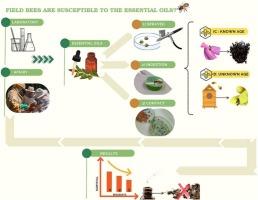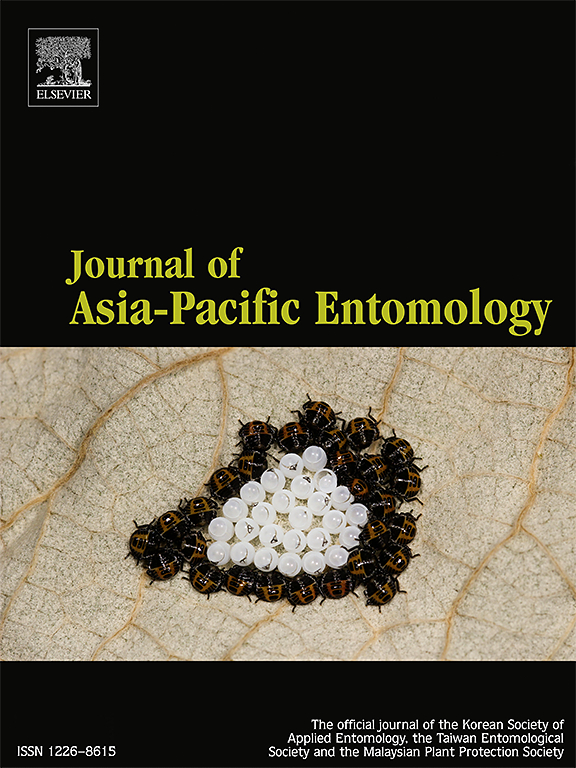单花尤金花和广藿香精油对非洲化蜜蜂的毒性研究(膜翅目:蜂科)
IF 1.3
3区 农林科学
Q3 ENTOMOLOGY
引用次数: 0
摘要
非洲蜜蜂是一种社会性昆虫,通过授粉、重要的生态系统服务和多种蜂产品的生产,在农业和经济中发挥着至关重要的作用。然而,蜂群的急剧减少,通常与蜂群衰竭失调(CCD)有关,特别是由于滥用杀虫剂,对生态系统和全球粮食安全构成重大威胁。在正在研究的替代合成农药的替代品中,精油或植物性杀虫剂脱颖而出,尽管对蜜蜂的影响仍然知之甚少,需要进一步研究。本研究评估了单叶Eugenia uniflora和广藿香cablin精油对已知年龄(K)和未知年龄(U)的觅食蜂的毒性。以0.75% (v/v)的浓度进行三次生物测定:(1)与处理表面直接接触;(二)对蜜蜂喷洒;(3)食用含有精油的食品;以及飞行行为的分析。精油显著降低了蜜蜂在12小时内的存活率,在暴露于单叶花精油的那一组中,有更致命的影响。它们对飞行行为(垂直运动和恢复自由落体)产生负面影响。无论蜜蜂的年龄或接触方法如何,毒性作用都是明显的,这突出表明,尽管植物杀虫剂通常被认为是比合成产品更安全的替代品,但它们仍可能对传粉媒介构成重大风险。该研究为传粉媒介保护提供了重要信息,可为今后植物性农药的监管提供参考,指导更安全的害虫综合治理(IPM)策略,促进害虫防治与生物多样性保护之间的平衡。本文章由计算机程序翻译,如有差异,请以英文原文为准。

Toxicity of the essential oils of Eugenia uniflora and Pogostemon cablin on field bees of Africanized Apis mellifera L., 1758 (Hymenoptera: Apidae)
Africanized honey bee Apis mellifera is a social insect that plays a vital role in agriculture and the economy through pollination, an essential ecosystem service, and the production of several bee products. However, the sharp decline in honey bee colonies, often associated with Colony Collapse Disorder (CCD), especially due to the indiscriminate use of pesticides, represents a significant threat to ecosystems and global food security. Among the alternatives under investigation to replace synthetic pesticides, essential oils or botanical insecticides stand out, although the effects on A. mellifera remain poorly understood and require further studies. This study evaluated the toxicity of essential oils from Eugenia uniflora and Pogostemon cablin on forager bees of known age (K) and unknown age (U). Three bioassays were conducted at a concentration of 0.75 % (v/v): (1) direct contact on treated surfaces; (2) spraying on bees; (3) Ingestion of food with essential oil; and analysis of flight behavior. Essential oils significantly reduced bee survival over 12 h, with more lethal effects in the group exposed to E. uniflora oil. They negatively affected flight behavior (vertical movement and recovery free fall). The toxic effects were evident regardless of honey bee age or exposure method, highlighting that although botanical insecticides are often considered safer alternatives to synthetic products, they can still pose substantial risks to pollinators. This study provides important information on pollinator conservation and may inform future regulations on botanical pesticides and guide safer integrated pest management (IPM) strategies, promoting a balance between pest control and biodiversity protection.
求助全文
通过发布文献求助,成功后即可免费获取论文全文。
去求助
来源期刊

Journal of Asia-pacific Entomology
Agricultural and Biological Sciences-Insect Science
CiteScore
2.70
自引率
6.70%
发文量
152
审稿时长
69 days
期刊介绍:
The journal publishes original research papers, review articles and short communications in the basic and applied area concerning insects, mites or other arthropods and nematodes of economic importance in agriculture, forestry, industry, human and animal health, and natural resource and environment management, and is the official journal of the Korean Society of Applied Entomology and the Taiwan Entomological Society.
 求助内容:
求助内容: 应助结果提醒方式:
应助结果提醒方式:


